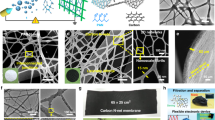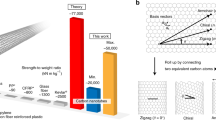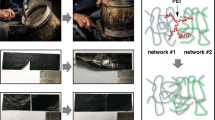Abstract
The mechanical failure of hybrid materials made from polymers and single-wall carbon nanotubes (SWNT) is primarily attributed to poor matrix–SWNT connectivity and severe phase segregation. Both problems can be successfully mitigated when the SWNT composite is made following the protocol of layer-by-layer assembly. This deposition technique prevents phase segregation of the polymer/SWNT binary system, and after subsequent crosslinking, the nanometre-scale uniform composite with SWNT loading as high as 50 wt% can be obtained. The free-standing SWNT/polyelectrolyte membranes delaminated from the substrate were found to be exceptionally strong with a tensile strength approaching that of hard ceramics. Because of the lightweight nature of SWNT composites, the prepared free-standing membranes can serve as components for a variety of long-lifetime devices.
This is a preview of subscription content, access via your institution
Access options
Subscribe to this journal
Receive 12 print issues and online access
$259.00 per year
only $21.58 per issue
Buy this article
- Purchase on Springer Link
- Instant access to full article PDF
Prices may be subject to local taxes which are calculated during checkout




Similar content being viewed by others
References
Wong, E.W., Sheehan, P.E. & Lieber, C.M. Nanobeam mechanics: elasticity, strength, and toughness of nanorods and nanotubes. Science 277, 1971–1975 (1997).
Popov, V.N., Van Doren, V.E. & Balkanski, M. Elastic properties of single-walled carbon nanotubes. Phys. Rev. B 61, 3078–3084 (2000).
Baughman, R.H. et al. Carbon nanotube actuators. Science 284, 1340–1344 (1999).
Qian, D., Dickey, E.C., Andrews, R. & Rantell, T. Load transfer and deformation mechanisms in carbon nanotube-polystyrene composites. Appl. Phys. Lett. 76, 2868–2870 (2000).
Yu, M.F. et al. Strength and breaking mechanism of multiwalled carbon nanotubes under tensile load. Science 287, 637–640 (2000).
Salvetat, J.P. et al. Elastic modulus of ordered and disordered multiwalled carbon nanotubes. Adv. Mater. 11, 161–165 (1999).
Shaffer, M.S.P. & Windle, A.H. Fabrication and characterization of carbon nanotube/poly(vinyl alcohol) composites. Adv. Mater. 11, 937–941 (1999).
Haggenmueller, R., Gommans, H.H., Rinzler, A.G., Fischer, J.E. & Winey, K.I. Aligned single-wall carbon nanotubes in composites by melt processing methods. Chem. Phys. Lett. 330, 219–225 (2000).
Watts, P.C.P. et al. A low resistance boron-doped carbon nanotube-polystyrene composite. J. Mater. Chem. 11, 2482–2488 (2001).
Vigolo, B. et al. Macroscopic fibers and ribbons of oriented carbon nanotubes. Science 290, 1331–1334 (2000).
Salvetat, J.P. et al. Elastic and shear moduli of single-walled carbon nanotube ropes. Phys. Rev. Lett. 82, 944–947 (1999).
Chen, J. et al. Dissolution of full-length single-walled carbon nanotubes. J. Phys. Chem. B 105, 2525–2528 (2001).
Frankland, S.J.V., Caglar, A., Brenner, D.W. & Griebel, M. Molecular simulation of the influence of chemical crosslinks on the shear strength of carbon nanotube-polymer interfaces. J. Phys. Chem. B 106, 3046–3048 (2002).
Star, A. et al. Preparation and properties of polymer-wrapped single-walled carbon nanotubes. Angew. Chem. Int. Edn Engl. 40, 1721–1725 (2001).
Decher, G. Fuzzy nanoassemblies toward layered polymeric multicomposites. Science 277, 1232–1237 (1997).
Wu, A., Yoo, D., Lee, J.K. & Rubner, M.F. Solid-state light-emitting devices based on the tris-chelated ruthenium(II) complex: 3. High efficiency devices via a layer-by-layer molecular-level blending approach. J. Am. Chem. Soc. 121, 4883–4891 (1999).
Mamedov, A.A., Belov, A., Giersig, M., Mamedova, N.N. & Kotov, N.A. Nanorainbows. Graded semiconductor films from quantum dots. J. Am. Chem. Soc. 123, 7738–7739 (2001).
Mamedov, A.A., Guldi, D.M., Prato, M. & Kotov, N.A. Layer-by-layer assembly of carbon nanotubes. Proceedings of 223rd ACS National Meeting, Orlando, Florida, United States, April 7–11, 2002, COLL-173, ACS, Washington D.C.
Rouse, J.H., Ounaies, Z., Lellehei, P.T. & Siochi, E.J. Incorporation of carbon nanotubes within stepwise assembled polyelectrolyte films. Proceedings of 223rd ACS National Meeting, Orlando, Florida, United States, April 7–11, 2002, COLL-169, ACS, Washington D.C.
Mamedov, A.A. & Kotov, N.A. Free-standing layer-by-layer assembled films of magnetite nanoparticles. Langmuir 16, 5530–5533 (2000).
Mawhinney, D.B. et al. Surface defect site density on single walled carbon nanotubes by titration. Chem. Phys. Lett. 324, 213–216 (2000).
Rols, S. et al. Diameter distribution of single wall carbon nanotubes in nanobundles. Eur. Phys. J. B 18, 201–205 (2000).
Westenhoff, S. & Kotov, N.A. Quantum dot on a rope. J. Am. Chem. Soc. 124, 2448–2449 (2002).
Sullivan, D.M. & Bruening, M.L. Ultrathin, ion-selective polyimide membranes prepared from layered polyelectrolytes. J. Am. Chem. Soc. 123, 11805–11806 (2001).
Li, F., Cheng, H.M., Bai, S., Su, G. & Dresselhaus, M.S. Tensile strength of single-walled carbon nanotubes directly measured from their macroscopic ropes. Appl. Phys. Lett. 77, 3161–3163 (2000).
Thompson, J.B. et al. Bone indentation recovery time correlates with bond reforming time. Nature 414, 773–776 (2001).
Smith, B.L. et al. Molecular mechanistic origin of the toughness of natural adhesives, fibres and composites. Nature 399, 761–763 (1999).
CRC Materials Science and Engineering Handbook (CRC, Boca Raton, Florida, USA, 1992).
Fu, S.Y. et al. Hybrid effects on tensile properties of hybrid short-glass-fiber- and short-carbon-fiber-reinforced polypropylene composites. J. Mater. Sci. 36, 1243–1251 (2001).
Yu, M.F., Files, B.S., Arepalli, S. & Ruoff, R.S. Tensile loading of ropes of single wall carbon nanotubes and their mechanical properties. Phys. Rev. Lett. 84, 5552–5555 (2000).
Garg, A. & Sinnott, S.B. Effect of chemical functionalization on the mechanical properties of carbon nanotubes. Chem. Phys. Lett. 295, 273–278 (1998).
Acknowledgements
N.A.K. thanks the financial support of this project from National Science Foundation (NSF)-CAREER, NSF-Biophotonics, Air Force Office of Scientific Research (AFOSR), Oklahoma Center for Advancement of Science and Technology (OCAST) and Nomadics. The authors are grateful to John Ostrander for polyelectrolyte film stretching, Phoebe Doss for assistance with TEM and SEM, and Zhandos Utegulov for carrying out the Raman scattering measurements. N.A.K. is indebted to Anatoli Kachurin (Sciperio, Stillwater, Oklahoma) for elemental analysis of the composites. The authors also thank Warren Ford (Oklahoma State University) for helpful discussions. Part of this work was carried out with support from the Office of Basic Energy Sciences of the US Department of Energy (NBRL 4410) and the European Union Human Potential Network, Chemical Functionalization of Carbon Nanotubes (FUNCARS), Ministero dell'Università e della Ricerca, Italy, Consiglio Nazionale delle Ricerche programme Materiali Innovativi (legge 95/95).
Correspondence and requests for materials should be addressed to N.A.K.
Author information
Authors and Affiliations
Corresponding author
Ethics declarations
Competing interests
The authors declare no competing financial interests.
Rights and permissions
About this article
Cite this article
Mamedov, A., Kotov, N., Prato, M. et al. Molecular design of strong single-wall carbon nanotube/polyelectrolyte multilayer composites. Nature Mater 1, 190–194 (2002). https://doi.org/10.1038/nmat747
Received:
Accepted:
Published:
Issue Date:
DOI: https://doi.org/10.1038/nmat747
This article is cited by
-
Efficient production of hydrogen and carbon nanotubes via the cracking of a waste cooking oil model compound over ordered mesoporous Ni/KIT-6 catalysts
Journal of Porous Materials (2024)
-
Fabricating strong and tough aramid fibers by small addition of carbon nanotubes
Nature Communications (2023)
-
Flexible piezoresistive strain sensor based on CNTs–polymer composites: a brief review
Carbon Letters (2022)
-
Characterize traction–separation relation and interfacial imperfections by data-driven machine learning models
Scientific Reports (2021)
-
Nanoarchitectonics for Nanocarbon Assembly and Composite
Journal of Inorganic and Organometallic Polymers and Materials (2020)



